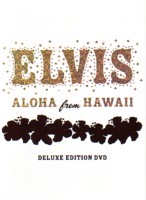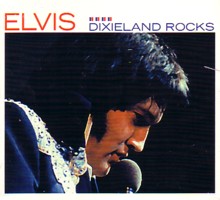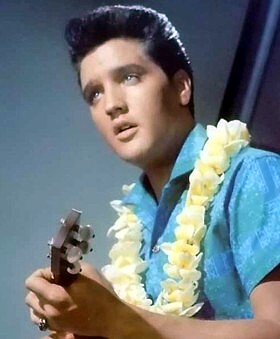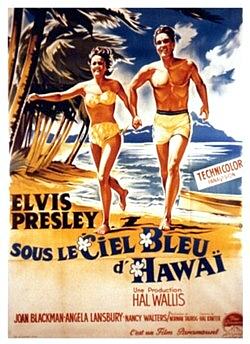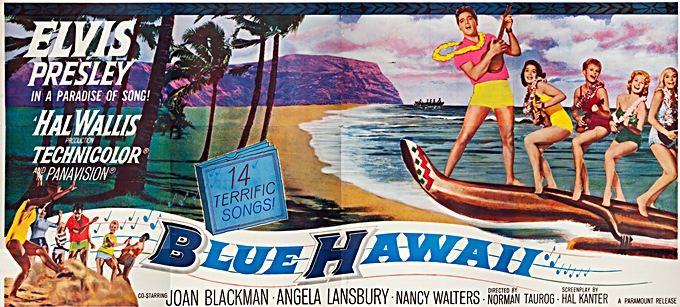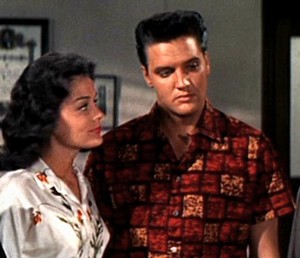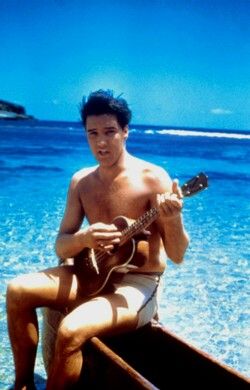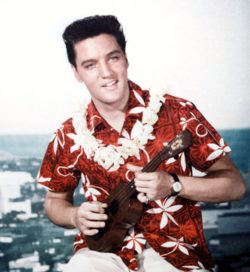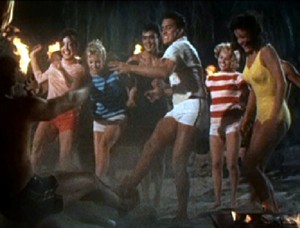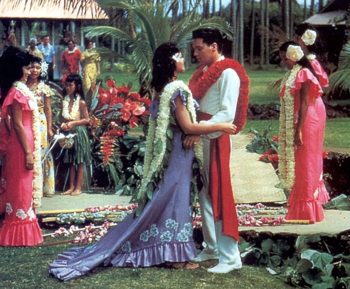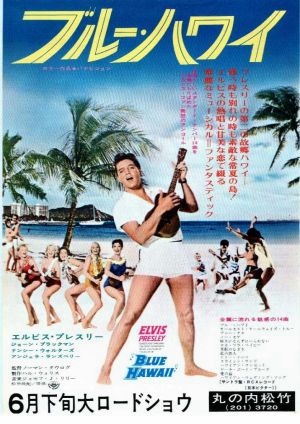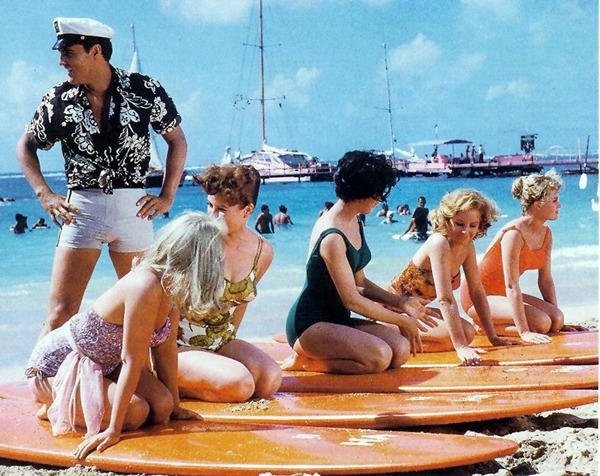 |
 |

Blue Hawaii is the movie that Elvis fans hate to love. It’s the movie that sowed the seeds of Elvis’ Hollywood demise and pulled him away from his roots. Yet is a movie of considerable charm more than 47 years after its original release.
I definitely can understand a lot of the bile that has been aimed at Blue Hawaii over the years. The movie, with its fluffy story and many disposable songs, does not challenge Elvis much as an actor and only mildly as a singer. Elvis’ early movies were often filled with top flight music that often challenged Elvis and brought him into contact with other revolutionary young players like Jerry Leiber or Mike Stoller. Blue Hawaii yielded the greatest percentage of filler fluff yet for an Elvis movie.
As an actor, Elvis had grown continuously in his first several movies and the characters he played had grown more complex each time. This culminated with the characters in King Creole and Flaming Star who had to face down moral conflicts in an immoral world. Elvis’ character in Blue Hawaii, like his character in GI Blues the year before, is a simple fellow. Like Tulsa McLean he’s relatively smart and imbued with leadership qualities. However, his ambition is extremely modest and seems to have few distinguishing character traits beyond a mild sense of humor and penchant to lapse into song occasionally. He has no noticeable character flaws. At least Tulsa was a womanizer. Not Chad, he’s a true blue one woman man- who doesn’t even really hint at owning a libido. He really could be any of one of a million bright innocuous young men across the early ‘60s US landscape or at least how those young men saw themselves.
Chad’s milieu is the rich and the upper middle class. His beach boy friends are not white but much of their existence is dedicated to revolving around the rich white man’s son. What’s more, Chad’s mother is concerned that these boys are not good enough for him; they’ll bring him down to their level.
In one of his (painfully) few insights, Albert Goldman accurately stated that Elvis and Blackman relate to each other like a brother and sister in the movie. (This is in contrast to Kid Galahad, done only months later where Blackman, in particular, burns with confident sexuality.)
The transition is there in the music as well. There is no twang in voice and no mumbles. The music is all perfectly clean pop. Except for the gospel undertones in "Can’t Help Falling in Love" there is nothing of the roots of Elvis Presley in any of the songs save his taste for mainstream pop. There’s no blues, no rockabilly, country and western and certainly no rock n’ roll. Nothing in the film even hints at the edge. Yet despite these flaws and the movie’s sluggish pacing, it’s very hard to dislike Blue Hawaii. In fact, the virtues that made the film a massive hit and its soundtrack an even bigger hit are just as easily perceived as the movie’s flaws, even nearly 50 years later.
In many ways, the movie has the same appeal as TVs Baywatch. When it’s freezing cold outside in the middle of winter (when this movie was released) and you have nowhere to go, it’s fun to watch beautiful people in a perfect climate partying and taking in some of the world’s scenic wonders. Plus, you’re enjoying these things with Elvis Presley. For female fans, it’s a dream date. For guys, you’re hanging out with the world’s coolest wing man, or you put yourself in Elvis’ place. It’s classic wish fulfillment. I think Blue Hawaii gives a little more than Baywatch. There’s the fluid assurance of early ‘60s Hollywood including the era’s bottomless array of great character actors. Here Roland Winters, Howard McNear, Steve Brody, and especially, Angela Lansbury all provide sharp comic moments. Hal Kanter’s screenplay (based on a story by Allan Weiss), pedestrian storyline and a handful of lame and too tame slapstick moments aside, contains some genuinely funny dialogue. Lansbury as Elvis’ mother gets most of the best laughs. Perhaps her funniest moment comes when she bemoans Elvis’ night in the local jail as a trip to the “Big House.” Then there’s Elvis himself. His portrayal of Chad Gates is hardly what one would call great acting, but he’s a picture of complete self-containment. He rules over this little environment like a musical Cary Grant, a perfectly charming guide on a winter trip to the Islands. He may not be dangerous, but he’s still cool.
Still, there’s a lot to like in this group of 14 songs that formed the biggest selling album Elvis had during his lifetime. The deeply spiritual romantic ballad "Can’t Help Falling in Love" gets better with every listen and is one of Elvis’ finest performances, although the version here is shorter and less assured than Elvis’ studio masterpiece. "Hawaiian Wedding Song" is also gorgeous and remains a big fan favorite. A less obvious highlight is Tepper and Bennett’s "Hawaiian Sunset" a lovely melodic appraisal of the Islands that could have been a standard had it been written 15 years earlier. "Island of Love" touches some of the same ground. Both are kind of extensions of the title tune which Elvis does just as well as Crosby. "Beach Boy Blues" is a funny little blues parody. And while Elvis’ immaculate version of the Island traditional "Aloha Oe" is not a major artistic statement, it is a perfectly realized performance that extends the theme of the project. This all may be pop music, but it is first rate pop.
Director Norman Taurog’s staging of this material is not always bursting with invention. Often Elvis sits in one place singing a song and the camera focuses on him either from a distance or close up. Taurog and Kanter have Elvis sing several songs in a concert type setting. (Despite his obvious facility with performance, no one suggests Elvis should stop wasting time on the tourist business and pursue a career on stage. I guess in the Elvis film universe everyone can sing like this.) Many have argued that it was a waste to have Elvis sing the deeply romantic "Can’t Help Falling in Love" to his girlfriend’s grandmother and they’re right. (Although it is not so much of a waste as the decision to have Frank Sinatra sing "Time after Time" to Jimmy Durante in It Happened in Brooklyn). For all that though, Taurog has his moments.
"Island of Love" takes us on a pastoral tour of Kauai. Taurog drops the movie’s pretense of using the music to forward the narrative or having Elvis perform in a concert type setting, using no close ups, the director uses a simple voice over as we see the sites while the characters ride through the scenery on horseback.
It’s a beautiful shot of continual motion as Taurog’s camera and the cast trail the raft to the conclusion of its short trip. Elvis and Blackman step back onto solid ground where a group of girls lift a flower arc over their heads, as the musicians flail away at the song’s climax, and Elvis plants a big ol’ kiss on Blackman for the fade out. It’s not Busby Berkeley, but the scene has a kind of romantic grandeur that would be a highlight in almost any movie. Taurog helmed many of Elvis’ weaker movies, but Blue Hawaii was their best pairing. When Blue Hawaii hit theaters in 1961 most fans responded to the film’s virtues and forgave its flaws. It made the top 20 films of the year for both 1961 and 1962 and the soundtrack album sat at the top of the charts for almost half a year. Ironically, such spectacular success, coming on the heels of the relative failure of two serious dramatic outings, spelled the end of Elvis’ attempts to become a serious film actor. Receipts showed the public preferred the light entertainer to the serious rebel artist. This is another reason many fans dislike the movie.
Spotlight by Harley Payette. Click here to comment on this article Go here to our recent spotlight "Aloha From Oahu, Hawaii. In search of Oahu Elvis" by Sanja Meegin
EIN Website content © Copyright the Elvis Information Network. Elvis Presley, Elvis and Graceland are trademarks of Elvis Presley Enterprises. The Elvis Information Network has been running since 1986 and is an EPE officially recognised Elvis fan club.
|
|
